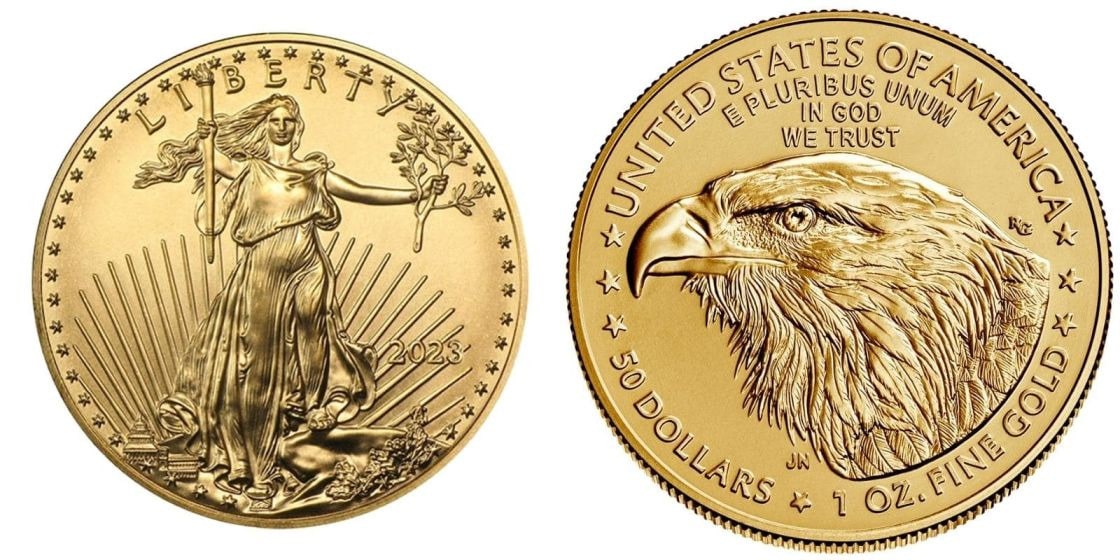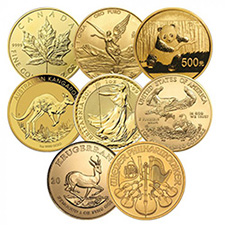Jump to: The US Mint | The Mint's History | Gold Bullion Coin Act | American Gold Eagles | Gold Eagle Design | American Gold Buffaloes | Gold Buffalo Design | Gold Buffalo vs Gold Eagle | Why Invest in Gold Bullion Coins?
Gold has long been a symbol of wealth and stability. In the United States, the American Gold Eagle and the American Gold Buffalo coins, both official bullion coins produced by the United States Mint, hold a special place in the hearts of collectors and investors.
In this article, we will delve into the distinct features, designs, compositions, and values of these iconic coins, shedding light on their unique appeal and why they are coveted by individuals seeking to invest in tangible assets and preserve their wealth.
The United States Mint

Seal of the United States Mint
The United States Mint is responsible for producing circulating coinage for the U.S. to conduct its trade and commerce and for manufacturing and distributing circulating precious metal, collectible coins, and national medals.
The U.S. Mint holds the exclusive role as the Nation's singular producer of legal tender coinage, tasked with creating coins for circulation that are vital for the country's trade and commerce operations.
The Mint's History
The U.S. Mint was established in 1792 as the first national Mint in the United States through the Coinage Act. The first Mint facility was located in Philadelphia.
The U.S Mint produces:
- Circulating coins;
- Numismatic products, including annual uncirculated coin sets;
- Commemorative coins, as authorized by Congress;
- Medal dies.

The Philadelphia facility produces coins and medal dies
Gold Bullion Coin Act of 1985
The Gold Bullion Coin Act of 1985, officially known as Public Law 99-185, was enacted by the United States Congress on December 17, 1985. This legislation authorized the creation of American silver and gold bullion coins.
The act aimed to allow investors to own and invest in precious metals through government-backed bullion coins. It paved the way for the American Gold Eagle and American Silver Eagle coin programs, which the United States Mint introduced in 1986.
These coins are prevalent among collectors and investors due to their quality, purity, and association with the U.S. government.
The American Gold Eagle Coin

The American Eagle gold coins are bullion coins produced by the United States Mint from 1907 through 1933 and are often considered one of America's most beautiful coins.
Within the United States, the American Gold Eagle coins hold legal tender status across all states and derive their content from the gold reserves maintained by the U.S. government.
According to the U.S. Mint, bullion coins have their weight, content, and purity backed by the United States government. They can even be included in an individual retirement account (IRA).
Composition specifications:
This gold alloy is composed of 91.67% gold and 3% silver, balancing copper with a reeded edge.
This type of gold is known as "crown gold" (or "fine gold") and has been used for minting various types of gold coins, including the famous South African Krugerrand.
However, the American Gold Eagles are unique in that, in spite the 22-karat composition, they are guaranteed to contain 1 full Troy ounce of gold, because the silver and copper content are added on top of the full Troy ounce of gold, meaning these coins are slightly heavier than other 24-karat coins, such as the Canadian Gold Maple Leaf.
The weight and diameter differ for the one--, half-, quarter-, and tenth-ounce sizes.
- One-Ounce Coin
- Face Value: $50
- Diameter: 1.287 inches (32.70 mm)
- Gold Content: 1.0000 troy ounce
- Weight: 1.0909 troy ounces (33.931 g)
- Half-Ounce Coin
- Face Value: $25
- Diameter: 1.063 inches (27.00 mm)
- Gold Content: 0.5000 troy ounce
- Weight: 0.5455 troy ounces (16.966 g)
- Quarter-Ounce Coin
- Face Value: $10
- Diameter: 0.866 inch (22.00 mm)
- Gold Content: 0.2500 troy ounce
- Weight: 0.2727 troy ounces (8.483 g)
- Tenth-Ounce Coin
- Face Value: $5
- Diameter: 0.650 inch (16.50 mm)
- Gold Content: 0.1000 troy ounce
- Weight: 0.1091 troy ounces (3.393 g)
Gold American Eagle's Design
From 1986 to 2021, the reverse carried an eagle carrying an olive branch while flying over a nest. Sculptor Miley Busiek created it.
One of the reasons that lead bullion investors to buy American gold eagle coins is their recognition as a trusted and internationally accepted form of investment, backed by the United States government for weight, content, and purity.
Additionally, their availability in various denominations and the historical significance of the design contribute to their appeal and demand among investors seeking to diversify and safeguard their portfolios.
Obverse Side

The obverse features a rendition of Augustus Saint-Gaudens' full-length figure of Lady Liberty with flowing hair while holding a torch in her right hand and an olive branch in the left to represent freedom, liberty, and opportunity. The sunrise behind her symbolizes a new beginning, hope, and a bright future.
Reverse

The original reverse design released in 1986 features a powerful and majestic male eagle and its family. The bald eagles are national birds and a symbol of the United States.
The eagle holds an olive branch, representing peace, in its right claw and arrows, symbolizing strength and defense, in its left claw. While the female eagle shields two eaglets inside the nest.

In 2021, to mark the 35th anniversary of the American Eagle Coin Program, the reverse was redesigned to show the portrait of an American bald eagle, as shown above. The inscriptions are UNITED STATES OF AMERICA, E PLURIBUS UNUM, and IN GOD WE TRUST.
The American Gold Buffalo Coin

The Gold Buffalo Coins are also some of the most sought-after products by the U.S. Mint. They were introduced by the United States Mint in 2006 and have been produced yearly since then.
Standing as the collectors' version of the traditional buffalo coins, every unit consists of a full troy ounce of 0.9999 pure gold, positioning the United States Mint at a level comparable to some of the globe's most valuable coins, like the Gold Canadian Maple Leaf.
American Gold Buffalo Coin Design
One of the most relevant gold buffalo features is its iconic design. James Earle Fraser was responsible for the design that remained used for 25 years and came back in the American Buffalo Commemorative Coin series.
The scene used for these gold buffalos is known to collectors as Fraser's 1913 Type I design.
American Buffalo Gold Bullion Coins are one ounce of. 9999 fine 24-karat gold, making them one of the purest gold coins available. They are official investment-grade coins with their weight, content, and purity entirely backed by the United States government.
Both obverse and reverse feature the original visuals of the American's five cents, issued initially from 1913 to 1938, known as the "Indian Head" or "Buffalo nickel."
Obverse

On the obverse side showcases a native american profile, in honor of the first inhabitants of the american lands, with the inscription "LIBERTY" above his face and the year placed on his shoulders.
Reverse

The reverse features an American Bison as a tribute to the pioneering spirit of the Nation's westward expansion.
Gold Buffalo vs. Gold Eagle
Both coins encapsulate the very essence of the American spirit, symbols of the American heritage and natural beauty.
Keep reading to learn more about the key differences between the design, composition, and value of both coins.
The Contrast Between The Designs
The American Eagle Gold Bullion Coin and the American Buffalo Gold Bullion Coin display elements deeply rooted in American culture and heritage, embodying a sense of patriotism and pride.
While their specific designs differ, they both feature iconic American symbols: the American gold Eagles represent freedom and liberty, and the American Buffalo gold coins symbolize the American West and the pioneering spirit of the Nation's expansion.
Additionally, they have inscriptions indicating their value and weight, showcasing essential details about the coin.
Composition and Gold Purity
Purity signifies the gold concentration within a coin, usually quantified by fineness or karats. Fineness denotes the gold concentration as a percentage, while karats indicate the proportion of gold to other metals out of 24 parts.
Gold with higher purity contains a more significant percentage of gold and is deemed more valuable.
The Gold Buffalo is crafted from 24-karat gold, boasting a remarkable purity of 99.99% with minimal presence of other metals, affirming its exceptionally high gold purity.
In contrast, the Gold Eagle is minted using 22-karat gold, maintaining a purity of 91.67% of the element gold. The remaining composition includes minor portions of copper and silver to add to the coin's durability.
While the Gold Buffalo achieves the most remarkable gold purity, the Gold Eagle's alloy enhances its durability for practical use.
Value
Since these two coins are bullion, their value will primarily rely on the value of the precious metals in their composition. In this case, the value of gold.
More than that, the availability, condition of the coin, mintage numbers, spot price of gold, and characteristics that can make the coin unique or scarce also contribute to its value, market demand, and investor sentiment.
Availability and Rarity
In simple terms, more Gold Eagle coins are available because they've been made longer and in more significant numbers. But the Buffalo Gold coin, made in smaller numbers and with a unique design, is seen as rarer and is wanted more by collectors.
The Gold Buffalo, crafted from 24-karat gold with limited minting, is often linked to a higher premium over the current gold market price. Its heightened purity and unique design increase its appeal to collectors and investors, increasing demand and potentially raising prices.
Conversely, the Gold Eagle, made from 22-karat gold with higher minting, typically carries a lesser premium over the current gold market price when compared to the Gold Buffalo.
The broader availability of Gold Eagles, notably in the 1 oz denomination, could be a factor in their comparatively lower prices than the Gold Buffalo.
Variety of Denomination
Gold Eagle coins are available in different denominations, which are 1/10 oz, 1/4 oz, 1/2 oz, and 1 oz. This broad variety allows bullion investors to choose the size of their investment based on their available budget and investment preferences.
However, the American Gold Buffalo Coins are only available in 1 oz.
Why Invest in U.S. Gold Bullion Coins?
In the face of historical economic turbulence, gold has stood as a beacon of stability. Stacking gold became a standard approach many investors rely on to protect their wealth.
In moments of high inflation, the price of gold often rises, providing a hedge against inflation.
Universal Currency

Illustrated above are other popular gold coins from mints around the world: the Canadian gold Maple Leaf (the most popular Canadian coin), the Australian Kangaroo Gold Coin, the Gold Britannia coins, the Austrian Gold Philharmonic, and the South African Krugerrand.
Gold is recognized and valued all around the world. Due to this global acceptance and historical significance, gold coins tend to be a highly liquid asset. They are easy to sell or buy.
Besides that, since gold price is not linked to any country's financial performance, it protects against country-specific financial risk.
Diversified Portfolio and Hedge Against Inflation

Distributing investments across different asset classes can protect an investor from losing all their profit if one of the options doesn't perform well.
It is the principle of diversification. One investment is independent of the other, so as an example, gold often does well if the stock market goes wrong.
Demand and Value
As a limited resource, the tendency is that as the demand increases over time, the price of gold also rises.
Unlike paper currency, gold coins can endure hundreds of years without losing value. Gold coins' value can also rise within the precious metals market depending on age, condition, or numismatic value. Even though silver coins can be more affordable, silver, in general, is more volatile than gold when it comes to value.

Gold consistently commands a higher price per ounce compared to silver coins.
The American Gold Buffalo and Gold Eagle coins share a typical composition of gold, and numerous design elements yet serve distinct purposes. The U.S. Mint produces the former for legal tender status, while the latter is crafted as bullion by a private mint.
Foreign mints like the Perth Mint or Royal Canadian Mint also create variations of these iconic gold coins.
Final Thoughts
Gold coins can be an attractive way of diversifying your investment portfolio. They not only have value preservation, but they also retain collectible appeal.
Being globally accepted and tangible, investing in gold bullion coins is likely one of the best options for protection against economic and political uncertainty.
















